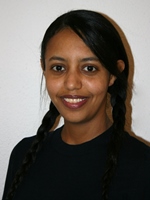MSc defence by Birhan Abera Kebede
 Birhan Abera Kebede from Ethiopia, MSc Fellow in Geology at the University of Iceland will give a presentation on her MSc project on Thursday 23 September, 2021 at 13:00. The presentation will be a part of the UI series "Open seminar at Masters-day of Natural Sciences" and will be 15 min long with 5 min allowance for questions.
Birhan Abera Kebede from Ethiopia, MSc Fellow in Geology at the University of Iceland will give a presentation on her MSc project on Thursday 23 September, 2021 at 13:00. The presentation will be a part of the UI series "Open seminar at Masters-day of Natural Sciences" and will be 15 min long with 5 min allowance for questions.
The title of the project is:
The Relationship between the Tulu Moye Geothermal System, the Ziway area and the Tectonic Structure of the Ethiopian Rift
Birhan's supervisors are:
Ásta Rut Hjartardóttir, Research specialist at the University of Iceland
Páll Einarsson, Professor at the University of Iceland
The external examiner is Gylfi Páll Hersir, Geophysicist at Iceland GeoSurvey - ISOR
Schedule is found on the UI website!
Abstract
The tectonic features of the Tulu Moye-Ziway area in the Central Main Ethiopian Rift (CMER) were mapped by using Digital Elevation Models, aerial photographs, and field observations. The study area consists of various tectonic features, such as normal faults, fissures, eruptive fissures, and caldera structures. Fissures and eruptive fissures are few and mainly trend N-NNE. The faults have different characteristics depending on their localities. In the southern part between Asela and Lake Ziway, most of them are older, and northeasterly oriented, forming horsts and grabens. They are situated near the eastern escarpment; representing the border fault system of the CMER which is formed by tectonic extension. The faults in the north, and a few in the southeastern part, are younger, volcano-tectonically active and belong to the Wonji Fault Belt (WFB). They are formed by extension deformation assisted by magmatic intrusion. The western part of this section includes a NW-striking fault system, while the N-NNE oriented fault swarm dominates in the eastern part. The crosscutting relationship shows that the NNE oriented faults predate the NW oriented faults. This section also hosts the active ~N-S striking Salen spreading axis, an aligned ridge of Holocene fissure eruptions and fractures. Three nested and partially visible caldera structures are identified by tracing caldera wall remnants. The Tulu Moye geothermal area is located where the calderas intersect the WFB, and surface hydrothermal alterations follow the caldera lineaments. This suggests that the geothermal activity is linked with the interaction between the caldera structures and the WFB.

